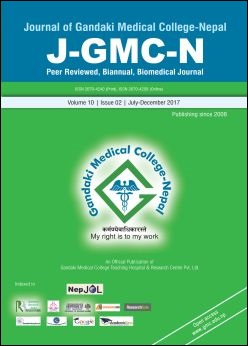A Hospital Based Study of 2015 Earthquake Injured Patients Attending the Medical College Hospital in Western Region of Nepal
DOI:
https://doi.org/10.3126/jgmcn.v10i2.20802Keywords:
Disaster, Earthquake, Hospital, Morbidity, NepalAbstract
Introduction: On April, 2015, at 11:56 Nepal Standard Time (06:11:26 UTC), a catastrophic earthquake with a magnitude of 7.8 - 8.1 on Richter scale and lasted approximately fifty seconds with Mercalli intensity of IX (Violent) hit the North West of Kathmandu, Nepal. Its epicenter was East of Gorkha District at Barpak, Gorkha, and its hypocenter was at a depth of approximately 8.2 km. It was the worst natural disaster to strike Nepal since the 1934 earthquake. The earthquake caused nearly 9,000 individuals death, injured 22,000 people and 3.5 million people were homeless.
Objectives: The main objective of this investigation was to study the demography profile, morbidity pattern, duration of hospital stay and mortality incidence among the 2015 earthquake injured patients visiting Emergency Department of Gandaki Medical College Teaching Hospital.
Methods: A retrospective analysis of the earthquake injured patients attending through the Emergency Department. All the earthquake injured patients attending the Emergency Department from 25th April to 24th May, 2015 were enrolled in our study. The collected data has been complied and analyzed using Statistical Package for the Social Science software package 16 version.
Results: Hundred and seventy patients were triage and 63% were females. Majority (44.2%) of patients were of age group of 15 - 34 years. Eighty one percent of patients were from Gorkha district, the epicenter site of the earthquake. The three most common diagnoses were trauma and orthopedic injuries (52.4%), mental health issues and psychological problems (21.2%) and reproductive health issues (16%). Among the 83% of patients who had been hospitalized, almost 34% were discharged within one week. Mortality rate was 1.2%.
Conclusions: Since 1993, earthquakes of more than or equal to 5.0 on the Richter scale have occurred in Nepal every year and this makes Nepal 11th most vulnerable country in world. Therefore, every hospital should have well functioning Earthquake Disaster Management Plan to handle this high intensity emergency situation in our country.
J-GMC-N | Volume 11 | Issue 01 | January-June 2018, Page: 11-15
Downloads
Downloads
Published
How to Cite
Issue
Section
License
This license allows reusers to distribute, remix, adapt, and build upon the material in any medium or format for noncommercial purposes only, and only so long as attribution is given to the creator.




